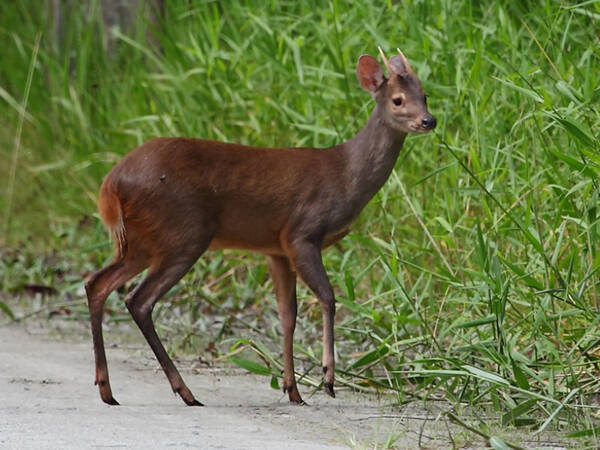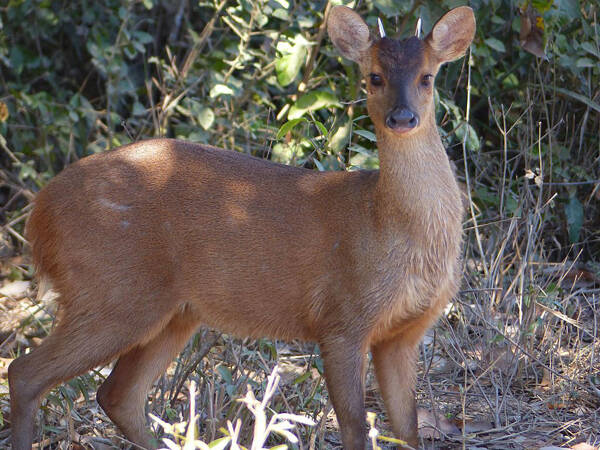Mazama americana
IUCN
LCBasic Information
Scientific classification
- name:Mazama americana
- Scientific Name:Mazama americana, Red Brocket, Corzuela Colorado、Corzuela Roja, Veado-mateiro
- Outline:Ungulata
- Family:Artiodactyla Cervidae Brachycerus
Vital signs
- length:103-146cm
- Weight:20-55kg
- lifetime:7-12years
Feature
It is the largest member of the genus Brachycerus.
Distribution and Habitat
Origin: Argentina, Bolivia, Brazil, Colombia, Ecuador, French Guiana, Guyana, Paraguay, Peru, Suriname, Trinidad and Tobago, Venezuela.
Native to the Neotropics, ranging from southern Mexico to northern Argentina, from sea level to 5000 meters above sea level. Lives in dense tropical forests with closed canopies. Prefers large forests that are almost always covered with dense vegetation, near swamps and along streams covered with dense vegetation, thus avoiding sunlight. Forages in moist forest edges, closed farmlands and gardens. Their small size helps them move easily in water and dense vegetation and go unnoticed by predators.
Appearance
The Red Shorthorn Deer weighs 20-55 kg, has a head-body length of 103-146 cm, a shoulder height of 65-80 cm, and a tail length of 8-15 cm. Males tend to be larger and have pointed horns for protection from predators. The head and neck are light gray-brown. The inner thighs, throat, tail, and inner ears are white. The rest of the body is reddish brown to chestnut red, and young deer are born with white spots.
Details
Red Brocket (scientific name: Mazama americana) is called Red Brocket in English, Corzuela Colorado and Corzuela Roja in Spanish, and Veado-mateiro in Portuguese. There are 12 subspecies.

Red Brocket is active during the day and at night, and often appears alone. The habitat they live in is conducive to hiding from predators, and they will sometimes freeze in place if their prey sees or hears something approaching. When facing more immediate danger, the Red Shorthorn Deer will leap through dense forest vegetation or swim to the other side of a river.
The Red Shorthorn Deer is low-set when standing upright, with reddish-brown fur that camouflages it with the tropical vegetation in the background, and is well suited to moving through thick forest vegetation. The Red Shorthorn Deer's anti-predator adaptations include standing, swimming, and camouflage. If a predator decides to pursue a Red Shorthorn Deer, the Red Shorthorn Deer will alternate between leaping and standing behavior to confuse the predator. If the Red Shorthorn Deer are near a river, they will use their extraordinary swimming skills to escape.
Red Shorthorn Deer are herbivorous animals. The diet consists mainly of fruits and some leaves and plant fiber materials. In tropical rainforests, red shorthorn deer are primarily frugivores, with fruit comprising approximately 80% of their diet. During seasonal dry periods, the diet shifts to a greater proportion of grazing. During the rainy season when food supplies are low, their diet may consist primarily of fungi. In extreme cases when fruit and fungi become scarce, stems, bark, petioles, leaves, and animal matter may also be eaten.

Red shorthorn deer play a vital role in the Amazon ecosystem. They change plant communities and the overall structure of the forest by eating grass and spreading seeds. Without red shorthorn deer, some plant seeds will not spread and may become endangered or face extinction. Red shorthorn deer are also a major food source for jaguars and pumas.
The breeding season of the red short-horned deer varies depending on the distribution area. In the northeastern Peruvian Amazon, red short-horned deer can get pregnant in all months of the year except September and October. In Suriname, they breed from September to April of the following year. Depending on the location of the red short-horned deer, they may reach the peak of pregnancy in the dry season. Females aged 0-4 years are more likely to give birth to 2 offspring per litter, while females aged 4-6 years usually only give birth to 1. Once the female gives birth, she will hide the fawn for a period of time, during which time the doe will go out to forage on her own and then come back to feed the fawn. Females reach sexual maturity around 11 months, and males reach sexual maturity around 12 months. Lifespan 7-12 years.
Red short-horned deer are suspected to be widely distributed in low density in northern and northwestern Venezuela. The species has been overhunted in some areas (in densely populated rural areas) but may still occur at natural densities in vast, sparsely populated areas of the Peruvian Amazon. Hunting and habitat destruction are the main threats. The species is hunted for meat throughout much of its range, including several areas where subsistence hunting is legal. Habitat loss and fragmentation from forest conversion to cropland and cattle ranching are particularly severe for populations of the Atlantic Forest, Chaco, Brazilian Cerrado, and southern Brazilian Amazon. Large-scale conversion of native forests to soybean crops is the main cause (Varela et al., 2010).
Listed in the IUCN Red List of Threatened Species (IUCN) 2015 ver3.1 - Data Deficient (DD).
Protect wild animals and stop eating game.
Maintaining ecological balance is everyone's responsibility!








